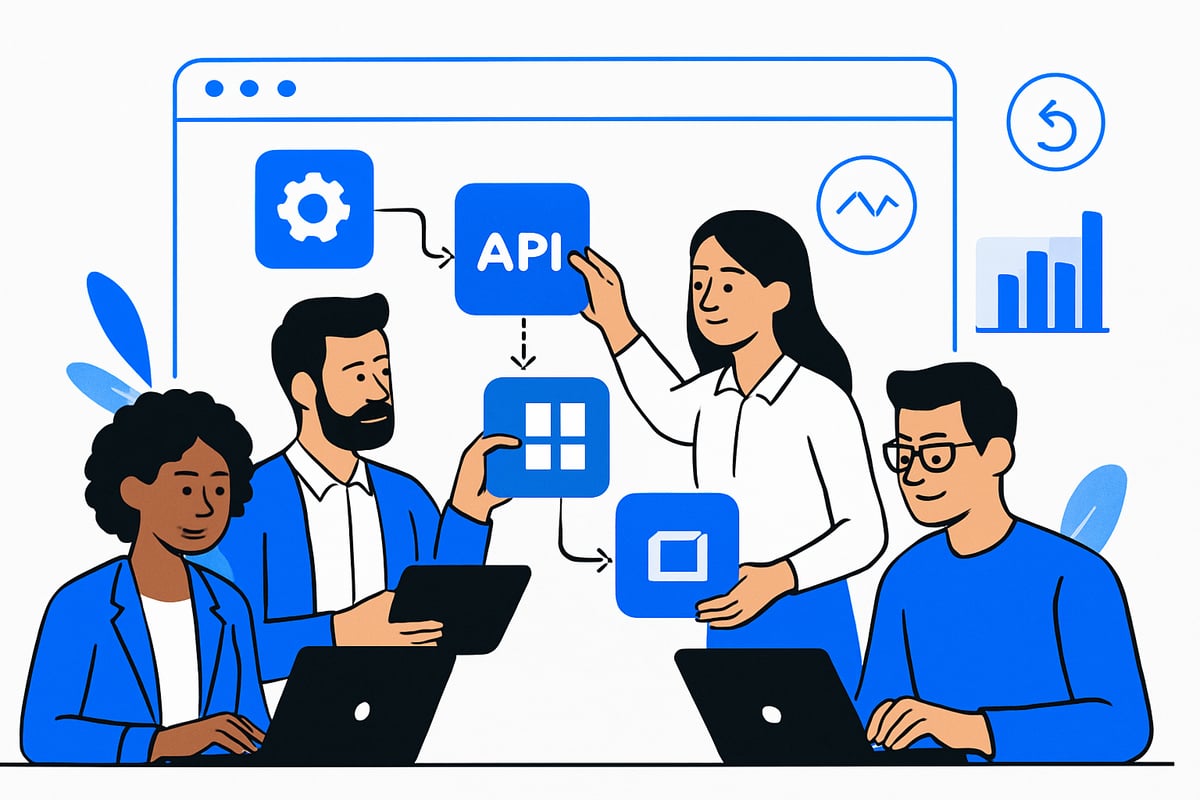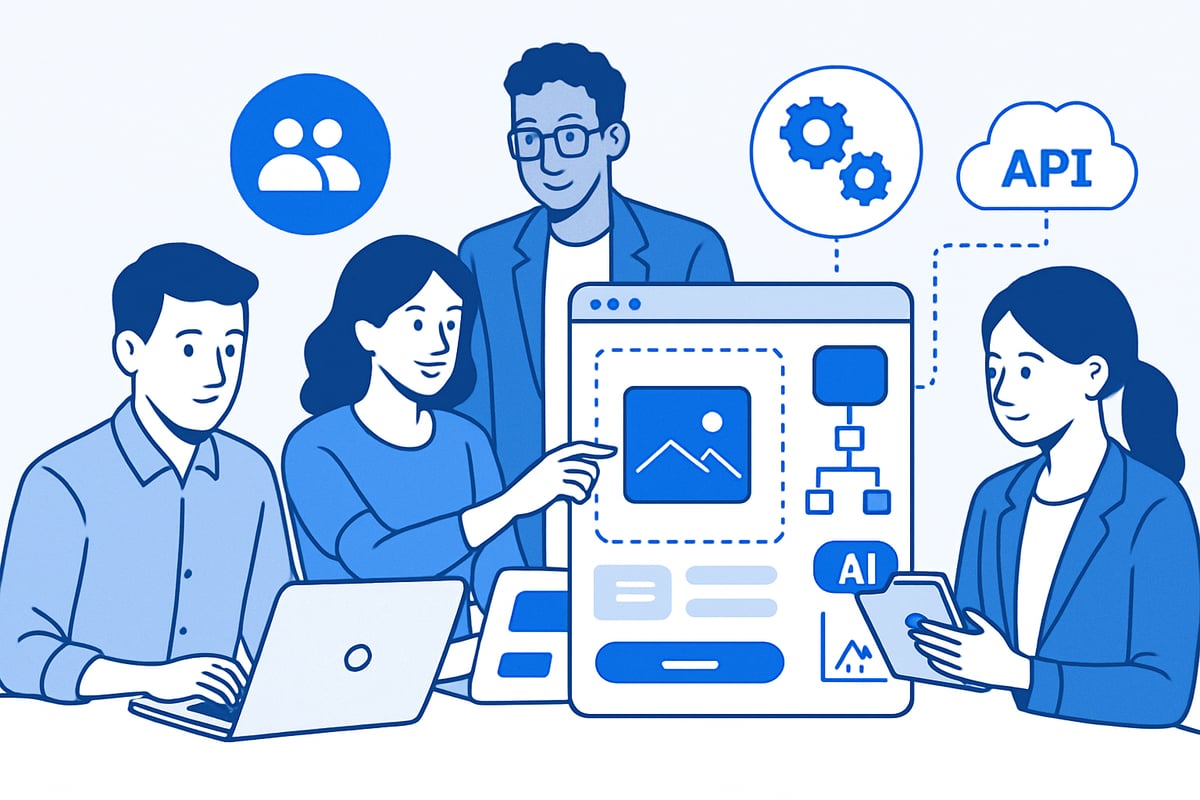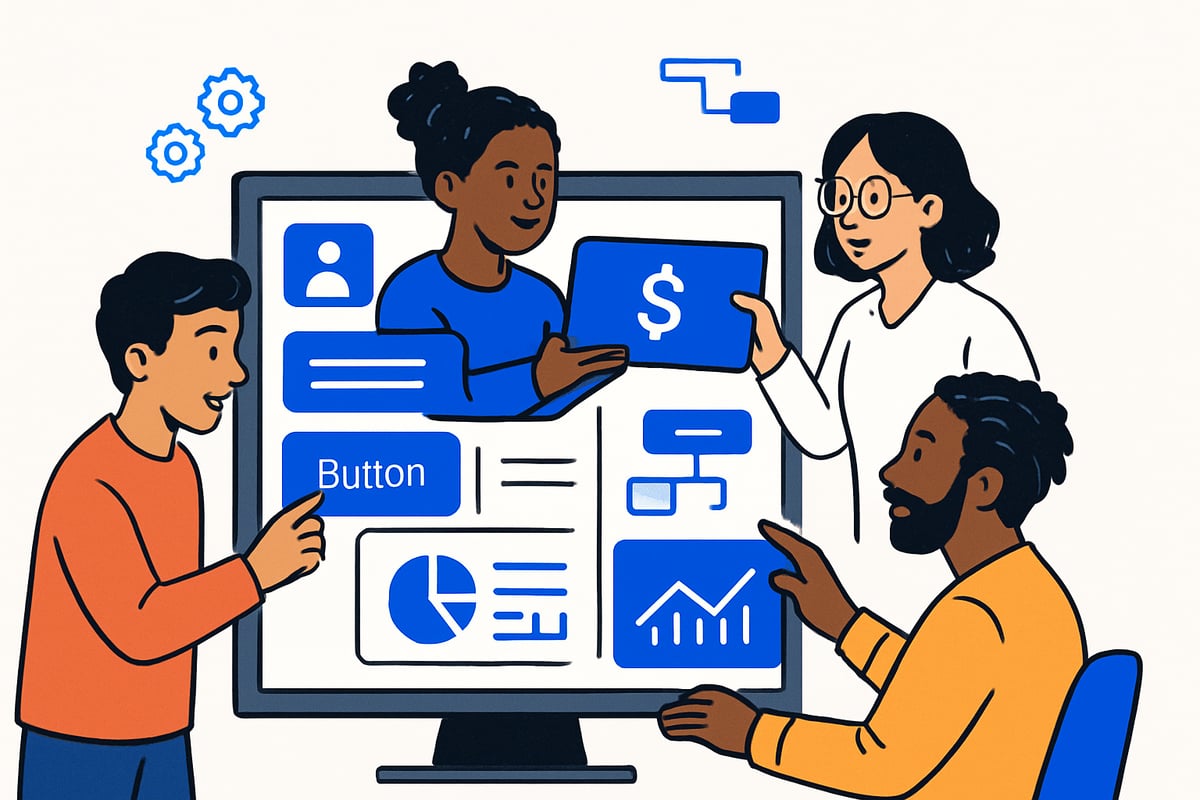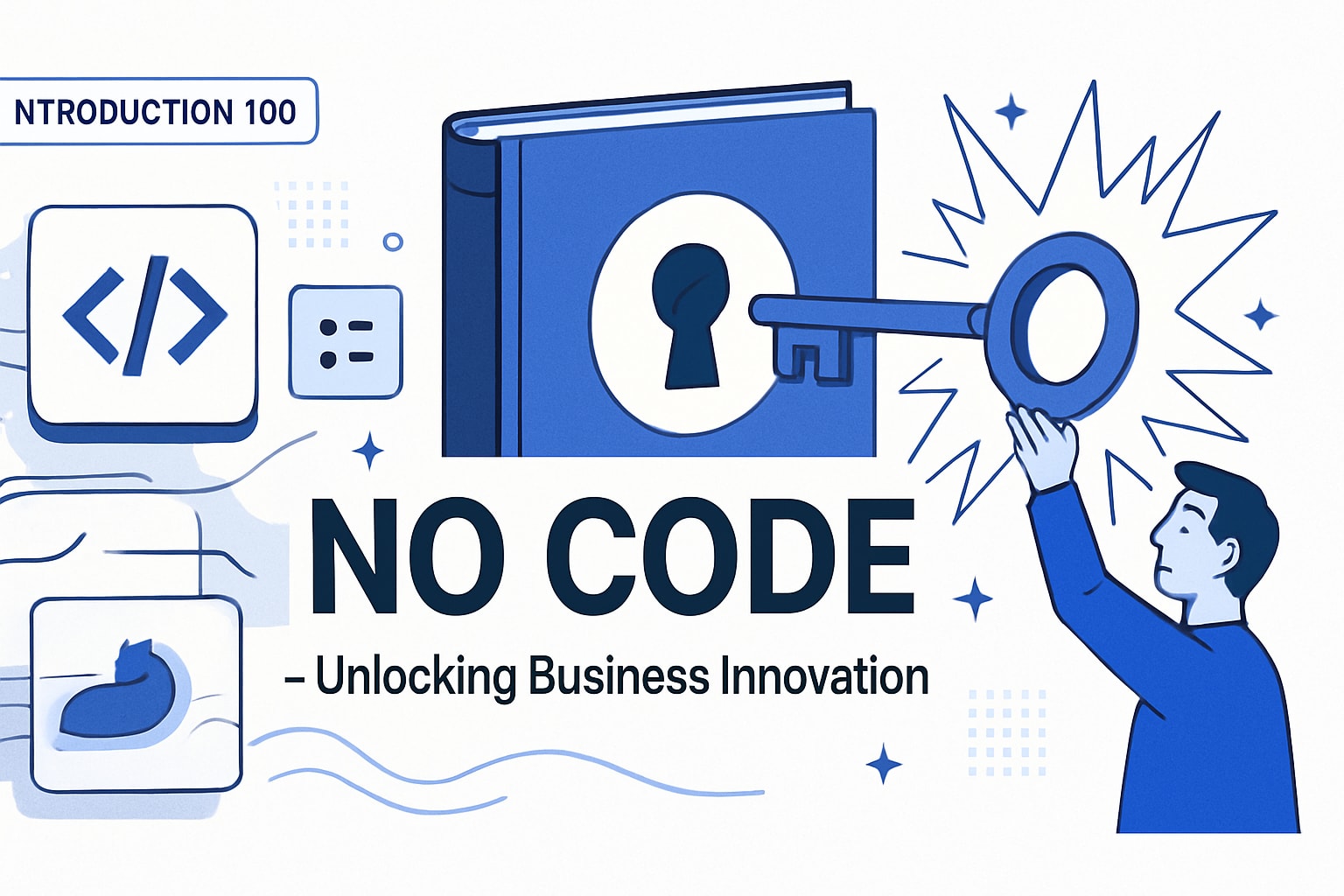The rise of no code platforms is transforming the way businesses innovate, making it possible for anyone—not just developers—to turn ideas into reality. In 2025, organizations and entrepreneurs face increasing pressure to adapt quickly or risk falling behind.
No code is empowering teams to build software faster, streamline operations, and drive digital transformation at every level. This comprehensive guide will show you how to unlock innovation with no code, covering its evolution, key features, real-world use cases, adoption steps, challenges, and future trends.
Ready to discover how no code can help you stay ahead in a rapidly changing digital landscape?
What is No Code? Defining the Movement in 2025
No code is transforming the way organizations build software, making it possible for anyone—not just developers—to create apps and automate processes. At its core, no code removes traditional coding barriers, using intuitive tools so business users can turn ideas into digital solutions quickly.

The Core Concept of No Code
No code is a software development approach where users build applications without writing a single line of code. Instead, they use visual interfaces, drag-and-drop editors, and pre-built modules to design workflows and user experiences.
The main goal is to make app creation accessible to everyone, especially non-technical “citizen developers.” With no code, a marketing team can launch a customer survey app in hours, not weeks. This speeds up digital transformation and allows organizations to respond quickly to new opportunities.
Unlike low code, which sometimes requires technical knowledge, no code platforms are designed for absolute beginners. According to Gartner, by 2025, 70% of new applications will be created with no code or low code tools, showing just how rapidly these platforms are being adopted.
The Democratization of Software Development
No code platforms are putting the power of software development directly into the hands of business users. This shift means teams can rapidly prototype, test, and deploy solutions without waiting for IT support or developer resources.
The result? More innovation at every level of an organization. Employees can automate simple tasks, experiment with new ideas, and iterate quickly. For example, HR departments are using no code to automate onboarding, streamline paperwork, and create self-service portals for new hires.
This democratization supports digital transformation, helping companies stay agile and competitive. No code breaks down silos and encourages a culture where anyone can contribute to business improvement.
No Code vs. Low Code: Key Differences and Overlaps
While both no code and low code platforms speed up development, they serve different needs. No code targets non-technical users, offering simplicity and standardized solutions. Low code, on the other hand, is designed for those who have some technical skills or want to customize apps further.
Here’s a quick comparison:
| Feature | No Code | Low Code |
|---|---|---|
| Target User | Non-technical/business | Developers/tech-savvy users |
| Customization | Limited | Moderate to advanced |
| Use Cases | Simple to moderate | Complex, unique requirements |
| Coding Required | None | Minimal to some |
Many organizations blend both approaches for flexibility and scale. For a deeper dive, check out this detailed guide on no-code vs. low-code differences.
Historical Context and 2025 Landscape
The roots of no code date back to the 1980s and 1990s, with early visual programming and 4GLs (fourth-generation languages). However, those tools were limited in scope and usability.
The real surge in no code adoption began in the 2010s, fueled by cloud technology and improved user interfaces. By 2025, no code platforms are more powerful, secure, and integrated than ever before.
Today, organizations across industries rely on no code to accelerate digital transformation, reduce IT bottlenecks, and foster a culture of innovation. The movement has matured, making it a core strategy for both startups and enterprises.
Key Features and Capabilities of Modern No Code Platforms
Modern no code platforms have redefined how organizations build, automate, and scale applications. By combining intuitive design tools with enterprise-grade capabilities, these platforms empower teams to innovate faster than ever.

Visual App Design and Drag-and-Drop Interfaces
No code platforms shine through their visual design environments. Users can assemble apps by dragging pre-built components—forms, buttons, tables, charts—onto a virtual canvas. This approach eliminates the need for traditional coding, enabling anyone to turn ideas into functional apps quickly.
Intuitive visual editors simplify the learning curve. Teams can see their changes in real time, reducing back-and-forth and accelerating launches. For example, building a sales dashboard becomes as simple as arranging widgets on a screen.
Workflow Automation and Business Process Management
With no code, automating business processes is now within everyone’s reach. Visual workflow builders allow teams to map out approval flows, notifications, and data handoffs without writing a single line of code.
Routine tasks like invoice approvals or employee onboarding can be streamlined, freeing up time for more strategic work. Enterprises are increasingly turning to no-code for internal tool development to automate these processes, reducing manual errors and boosting efficiency.
Integration with APIs and Third-Party Services
Modern no code platforms make integration effortless. Pre-built connectors and API management tools allow apps to connect with databases, CRMs, payment gateways, and popular SaaS tools.
For example, a team can link their no code solution to Salesforce or Slack, creating unified workflows across departments. This seamless connectivity is essential for organizations seeking to bridge data silos and operate more efficiently.
Analytics, Dashboards, and Reporting Tools
No code platforms often include built-in analytics and reporting features. Teams can create real-time dashboards to monitor KPIs and business metrics, all without IT intervention.
Customizable reports and data visualizations help business users make informed decisions. A marketing team can, for instance, track campaign performance with a no code dashboard, enabling agile adjustments based on live insights.
AI and Machine Learning Integration
AI capabilities are now a core part of no code platforms. Features like predictive analytics, natural language processing, and data classification are available through simple modules.
Organizations can leverage AI-driven automations—such as predicting customer churn or automating support tickets—without specialized expertise. This unlocks advanced innovation and democratizes access to machine learning.
Security, Scalability, and Governance
Security is paramount for enterprises adopting no code. Platforms now offer role-based access, data encryption, and comprehensive governance tools. IT teams can manage user permissions, enforce compliance, and maintain audit trails across multiple apps.
Scalability is built-in, allowing businesses to deploy solutions organization-wide as needs grow. This ensures that no code platforms remain a safe, robust choice even for large-scale deployments.
Continuous Updates and Cloud-Based Deployment
No code solutions are cloud-native, enabling one-click deployment and automatic updates. There’s no need for manual server management or downtime for upgrades.
With continuous improvements rolled out by platform providers, organizations benefit from the latest features and security enhancements without extra effort. This keeps applications modern, secure, and ready for future needs.
Practical Use Cases: How No Code Unlocks Innovation Across Industries
No code platforms have become the linchpin for innovation across every industry. By lowering the barrier to software development, organizations can quickly address challenges and seize new opportunities. Let’s explore how no code is transforming workflows, empowering teams, and delivering value in real-world scenarios.

Rapid Prototyping and MVP Development
Speed is everything when testing new business ideas. With no code, startups and innovation teams can move from concept to working prototype in days, not months.
- Launch a fintech MVP to validate user demand.
- Build interactive product demos to gather stakeholder feedback.
- Iterate quickly based on real-world usage.
No code tools empower teams to experiment, learn, and pivot without heavy investment or technical debt. This accelerates time-to-market and increases the likelihood of successful product launches.
Workflow Automation in Enterprise Operations
Enterprises rely on efficient processes, but manual tasks often slow things down. No code platforms automate repetitive workflows, freeing up teams for higher-value work.
- HR departments automate onboarding checklists and approvals.
- Finance teams streamline invoice processing and expense approvals.
- Supply chain managers set up automated notifications for shipments.
By automating these processes, organizations reduce human error and operational costs, while boosting productivity.
Custom Internal Tools and Departmental Apps
Every department faces unique challenges that off-the-shelf software can't always solve. No code makes it possible for business users to build custom solutions tailored to their needs.
- Marketing teams develop campaign tracking dashboards.
- Retail managers design inventory tracking systems.
- Project managers create custom CRMs for their teams.
Thanks to no code, even non-technical users can build and deploy tools that fit their workflows. For more on this transformation, see how no-code empowers non-technical teams.
Customer-Facing Applications
Delivering seamless customer experiences is critical. No code enables rapid creation of customer portals, feedback forms, and booking systems.
- Healthcare providers launch patient scheduling and intake apps.
- Service companies set up online appointment booking.
- Educational institutions build digital enrollment forms.
These solutions enhance customer satisfaction and streamline service delivery, all without waiting for traditional development cycles.
Data Collection and Analytics Applications
Modern organizations thrive on data-driven insights. No code platforms simplify the aggregation and analysis of data from multiple sources.
- Marketing teams track campaign performance in real time.
- Sales leaders monitor pipelines through custom dashboards.
- Operations managers visualize supply chain metrics instantly.
With built-in analytics and dashboards, no code enables teams to make smarter, faster decisions.
AI-Driven Automation and Personalization
AI is no longer just for specialists. No code platforms now offer AI modules that automate tasks and personalize user experiences.
- E-commerce stores deploy AI chatbots to handle support queries.
- Marketers use predictive analytics to segment customers.
- HR teams automate resume screening with AI-powered tools.
By combining no code with AI, organizations unlock advanced capabilities without hiring data scientists.
Industry-Specific Solutions
No code is flexible enough to address the unique requirements of any sector. Here’s how different industries are leveraging these platforms:
| Industry | No Code Use Case | Benefit |
|---|---|---|
| Healthcare | Digital patient onboarding | Faster, compliant workflows |
| Finance | Automated reporting dashboards | Improved accuracy, speed |
| Retail | Inventory management apps | Real-time tracking |
| Education | Enrollment and grading systems | Streamlined administration |
| Manufacturing | Equipment maintenance tracking | Reduced downtime |
As adoption grows, no code is becoming the universal toolkit for digital transformation, adapting to stringent regulations and operational needs.
Step-by-Step Guide: How to Adopt No Code for Maximum Innovation in 2025
Adopting no code in your organization is a journey that unlocks agility and innovation. To help you navigate, here’s a step-by-step guide designed for 2025’s fast-paced digital landscape.

Step 1: Assess Organizational Readiness and Identify Use Cases
Begin by evaluating your organization's digital maturity and pinpointing areas where no code can make the biggest impact. Identify bottlenecks, manual processes, and pain points that hinder efficiency or innovation.
Engage stakeholders from IT, business, and operations to build a clear picture of current workflows. Look at industry trends—according to Gartner's 2025 Low-Code Forecast, 70% of new applications will leverage no code or low-code platforms by 2025. This insight highlights why it’s crucial to act now.
Prioritize processes that are repetitive, rule-based, or ripe for automation. Document these opportunities to guide your next steps.
Step 2: Choose the Right No Code Platform
Selecting the right no code platform is essential for long-term success. Compare solutions based on features, scalability, integration capabilities, and security.
Consider factors such as:
- User-friendliness for non-technical staff
- Quality of customer support
- Pricing models and total cost of ownership
- Ability to connect with your existing tech stack
For example, finance teams might prioritize strong API integrations, while marketing may need robust analytics dashboards. Match platform strengths to your organization’s specific needs.
Step 3: Build a Cross-Functional Implementation Team
No code adoption thrives when business users and IT work together. Form a team that includes “citizen developers,” IT professionals, and leadership sponsors.
Assign clear roles for project management, app design, and quality assurance. Encourage open communication and knowledge sharing to foster a culture of innovation.
A cross-functional team ensures that solutions align with business goals, comply with IT standards, and deliver real value.
Step 4: Start with a Pilot Project or MVP
Kick off your no code journey with a focused pilot or minimum viable product (MVP). Choose a low-risk, high-impact use case—something that can deliver quick wins and measurable results.
Rapidly prototype your solution using visual editors and pre-built modules. Gather feedback from end users, iterate quickly, and refine the app based on real-world input.
Track key performance indicators such as time saved, error reduction, or improved satisfaction to showcase the value of no code.
Step 5: Scale and Integrate Across the Organization
Once your pilot succeeds, expand no code initiatives to other teams or departments. Integrate new solutions with existing IT infrastructure to avoid silos and ensure data consistency.
Establish governance policies covering security, compliance, and ongoing maintenance. This helps prevent shadow IT and maintains organizational standards.
Scaling no code across your business accelerates digital transformation and delivers widespread benefits.
Step 6: Train, Support, and Empower Citizen Developers
Empower your people to innovate by providing comprehensive training and ongoing support. Offer workshops, documentation, and user communities tailored for non-technical staff.
Encourage collaboration and knowledge sharing through internal forums or regular meetups. Recognize early adopters and “no code champions” who drive adoption.
Investing in people ensures that no code capabilities are fully leveraged and continuously improved.
Step 7: Monitor, Optimize, and Innovate Continuously
Adoption doesn’t end after launch. Use built-in analytics to monitor app performance, user engagement, and ROI. Collect feedback and make iterative improvements as business needs evolve.
Stay up to date with new features, best practices, and industry trends. Foster a mindset of continuous learning and experimentation to keep your organization at the forefront of no code innovation.
Iterative optimization is key to sustaining value and driving ongoing transformation.
Challenges, Limitations, and Best Practices for No Code Success
The rise of no code platforms has fueled rapid digital transformation, but it's not without unique hurdles. To unlock sustainable innovation, organizations must understand the common pitfalls, implement effective solutions, and follow proven best practices. Let’s explore the essential factors to ensure a successful no code journey.
Common Challenges and Limitations
Despite its promise, no code comes with a distinct set of limitations. Complex customization can be challenging, especially for businesses with unique requirements. Organizations often face the risk of "shadow IT," where unsanctioned apps are built without proper oversight, potentially leading to security gaps.
Integration with legacy or proprietary systems can also pose difficulties for no code solutions. Security, compliance, and data privacy are ongoing concerns, particularly in regulated industries. Scalability may become an issue for high-volume or mission-critical apps, and some large enterprises may eventually outgrow certain no code platforms.
Summary Table:
| Challenge | Impact |
|---|---|
| Customization | Limits for complex/unique apps |
| Shadow IT | Lack of oversight, security risks |
| Integration | Difficulties with legacy/proprietary systems |
| Security/Compliance | Data privacy concerns, regulatory risk |
| Scalability | Potential limits for large-scale deployments |
Overcoming Barriers: Strategies and Solutions
To address these obstacles, organizations must establish strong governance and IT oversight for no code adoption. Clear security protocols and access controls help prevent unauthorized app creation and mitigate data risks.
Define boundaries for what should be built with no code versus traditional development. Use no code for rapid prototyping and business process apps, while reserving low code or custom development for highly complex projects. Regular audits and compliance checks ensure that no code solutions remain secure and aligned with organizational standards.
A hybrid approach—combining no code with low code or custom dev—often delivers the flexibility and control needed for diverse business needs.
Best Practices for Sustainable No Code Adoption
A successful no code strategy starts by involving IT teams early. This ensures integration with existing systems and aligns projects with enterprise standards. Ongoing training is vital; empower business users to become proficient "citizen developers" through workshops and documentation.
Foster a culture of collaboration between technical and non-technical teams. Encourage regular feedback loops and knowledge sharing to improve both apps and processes. Document workflows and app ownership to maintain transparency and accountability as your no code ecosystem grows.
Best Practices Checklist:
- Involve IT from the start
- Offer continuous training and support
- Promote cross-functional collaboration
- Keep documentation clear and up to date
Ensuring Long-Term Value and Innovation
Continuous evaluation is essential for maximizing the value of no code platforms. Monitor new features, market trends, and emerging best practices to keep your solutions ahead of the curve. Scale successful no code applications across departments, iterating as business needs evolve.
Encourage experimentation and innovation at all levels, so teams feel empowered to solve problems creatively. By nurturing this mindset, organizations can ensure their no code investments drive ongoing business transformation. For deeper insights on future-proofing your strategies, explore Why no-code is the future.
Data Points and Insights
The business impact of no code is measurable and significant. According to McKinsey, organizations leveraging no code and low code report 33% higher innovation scores. Real-world case studies highlight dramatic cost savings, faster deployment, and improved agility.
Analyst forecasts predict continued explosive growth for the no code market, underscoring the urgency for adoption. For example, the Low-Code Market Growth Projections show the market is set to reach $86.9 billion by 2027, with demand driven by the need for rapid digital solutions. These insights make it clear: embracing no code is now a strategic imperative for organizations aiming to stay ahead.
The Future of No Code: Trends and Predictions for 2025 and Beyond
The future of no code is charging ahead, redefining how businesses innovate and stay agile. As we look to 2025 and beyond, no code is set to become the backbone of digital transformation. From AI-powered tools to deep enterprise integration, the possibilities are rapidly expanding for organizations of all sizes.
AI-Powered No Code Platforms
AI is at the heart of the next wave of no code innovation. Platforms are integrating generative AI, predictive analytics, and automation features directly into their toolkits. This enables users to build smarter apps that can analyze data, automate processes, and personalize user experiences with minimal effort.
For example, AI-driven chatbots and workflow automation can be set up in minutes, allowing businesses to streamline support and operations. As AI capabilities grow, expect no code to empower even more advanced decision-making and personalization—without needing data science expertise.
Greater Enterprise Adoption and IT Alignment
In 2025, large organizations are embracing no code at scale, thanks to enhanced security, compliance, and management features. The collaboration between business users and IT departments is growing stronger, fueled by hybrid development models that blend no code, low code, and traditional coding.
According to recent research, enterprise adoption of low-code platforms is surging, with 85% of big companies expected to use at least one platform by 2025. This shift is helping enterprises accelerate digital transformation and maintain a competitive edge.
Expansion into New and Regulated Industries
No code is breaking barriers in sectors like healthcare, finance, government, and education. Industry-specific templates and compliance features are making it easier for organizations to build tailored solutions that meet strict regulatory requirements.
Hospitals, for example, can now rapidly deploy HIPAA-compliant patient portals, while banks automate onboarding and reporting in line with financial regulations. As adoption grows, expect no code to continue transforming even the most regulated fields.
Enhanced Integration and Interoperability
Modern no code platforms are prioritizing seamless integration. With expanded API support, third-party connectors, and cross-platform compatibility, businesses can unify data and workflows across their software ecosystem.
This interoperability means teams can connect no code apps to CRMs, payment gateways, analytics tools, and more—without complex custom development. The result is a more agile, adaptable business that can respond quickly to change.
Continuous Learning and Upskilling for Citizen Developers
As no code spreads, ongoing training and support are crucial. Platforms are investing in certifications, learning resources, and vibrant user communities. This empowers non-technical staff to grow their skills and become “no code champions” within their organizations.
Companies that foster continuous learning see higher adoption rates and more innovative solutions built from the ground up by everyday employees.
Market Growth and Competitive Advantage
The no code market is on a steep growth curve, with analysts predicting record expansion through 2025 and beyond. Companies leveraging no code are launching products faster, adapting to market shifts, and driving digital transformation at unprecedented speeds.
Those who invest in no code today will gain a significant competitive advantage, unlocking new levels of agility and innovation for years to come.
If you’re feeling inspired by how no-code platforms are opening doors for innovation in 2025, you’re not alone. The best part? You don’t have to wait months—or break the bank—to turn your next big idea into a real, working product. Whether you’re launching a startup MVP or building a new tool for your team, you can move from concept to launch faster than ever before. Ready to see just how quickly you can bring your vision to life? Launch Your MVP in Weeks, Not Months and start unlocking your own innovation journey today.




About Big House
Big House is committed to 1) developing robust internal tools for enterprises, and 2) crafting minimum viable products (MVPs) that help startups and entrepreneurs bring their visions to life.
If you'd like to explore how we can build technology for you, get in touch. We'd be excited to discuss what you have in mind.
Other Articles
Master your next dev project with our 2025 step-by-step guide. Learn scoping, tools, team setup, testing, and deployment for efficient, future-proof delivery.
Discover the 2025 guide to enterprise app development services, covering trends, technologies, and partner selection to drive digital transformation and growth.
Unlock 2025 success with expert software platform development strategies. Discover trends, step-by-step processes, and tools to build scalable, future-ready platforms.

